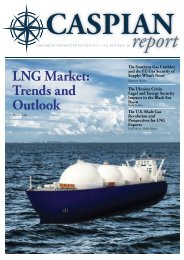Caspian Report - Issue: 07 - Spring 2014
Create successful ePaper yourself
Turn your PDF publications into a flip-book with our unique Google optimized e-Paper software.
cally independent entities, properly<br />
equipped with human and financial<br />
resources.<br />
The European Commission’s (EC)<br />
recent Recommendation “on the<br />
exploration and production of hydrocarbons<br />
(such as shale gas)<br />
using high volume hydraulic fracturing<br />
in the EU” 4 has put forward<br />
a unified framework for shale gas<br />
activities EU-wide. Building on the<br />
IEA’s (2012) golden rules for natural<br />
gas production, the Recommendation<br />
offers conceptual clarifications<br />
and urges strict operational<br />
safeguards to ensure environmental<br />
protection and adequate public<br />
involvement.<br />
In a scenario of increasing social<br />
acceptance and confirmed commercially<br />
exploitable reserves, Romanian<br />
shale gas could enter the<br />
market towards 2020. By then, hydraulic<br />
fracturing technology will<br />
probably be better understood in<br />
the public sphere, and hence a less<br />
frightening prospect.<br />
Transforming trends in<br />
the European natural gas<br />
markets<br />
In each of these domestic directions<br />
of new gas sources development, an<br />
additional element of unpredictability<br />
has to do with potential competition<br />
from pipeline imports. Several<br />
recent developments in the region<br />
are for the first time creating the<br />
likelihood of a liquid energy market<br />
in Central and Eastern Europe by<br />
the end of the current decade:<br />
(a) The growing interconnectivity<br />
of Eastern Europe’s national natural<br />
gas grids, which will allow for new<br />
trading relations, are superimposed<br />
on the East-West geographical setting<br />
of the large Soviet-era pipelines.<br />
Romania is already interconnected<br />
with Hungary (albeit only west-toeast)<br />
while reverse flow interconnections<br />
with Bulgaria and Moldova<br />
are to be completed in <strong>2014</strong>.<br />
(b) The EU competition and market<br />
liberalisation policies passed<br />
at the beginning of the 1990s have<br />
become genuinely effective over the<br />
last few years, significantly limiting<br />
monopolistic practices within the<br />
European energy markets.<br />
(c) A global trend that has supported<br />
and stimulated gas-to-gas<br />
trade in Western Europe adds to<br />
the dynamic: the North American<br />
“shale gas revolution.” This made<br />
large quantities of Qatari LNG originally<br />
prepared for the American regasification<br />
terminals in the Gulf of<br />
Mexico available to Europe and Asia.<br />
Consequently, natural gas traded on<br />
the British, Belgian, Dutch and German<br />
hubs has become cheaper than<br />
the gas piped from Gazprom, Statoil<br />
or Sonatrach, and has led to increased<br />
contractual flexibility with<br />
these traditional suppliers.<br />
The long-term contracts (LTCs) concluded<br />
between large utility companies<br />
from Germany, Italy and France<br />
– Eni, E.On Ruhrgas, RWE, Wintershall,<br />
GDF Suez – and Gazprom were<br />
for decades solid and lucrative, enabling<br />
these companies to operate<br />
97<br />
CASPIAN REPORT, sprıng <strong>2014</strong><br />
4.<br />
European Commission (<strong>2014</strong>), COM(<strong>2014</strong>) 23 final, January 22.










